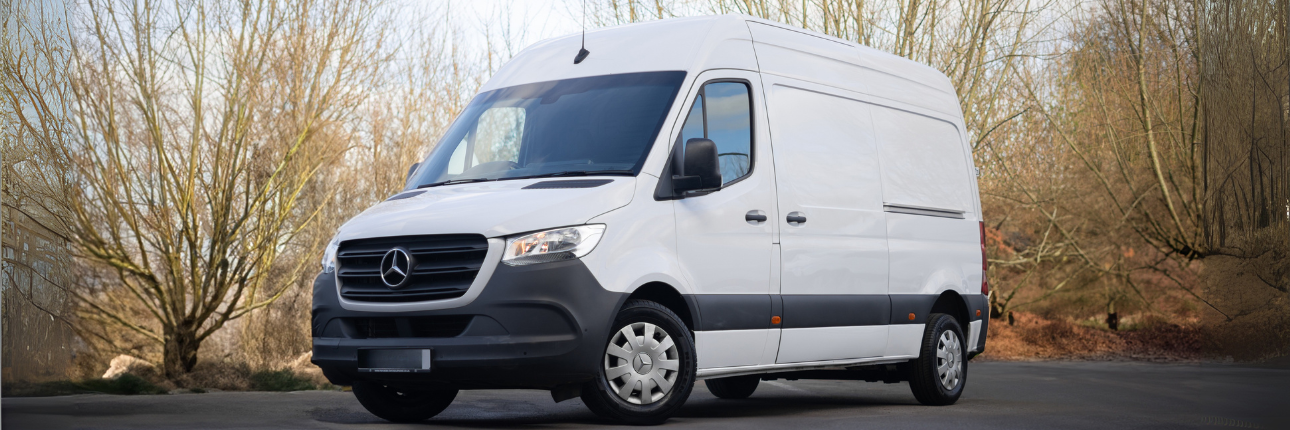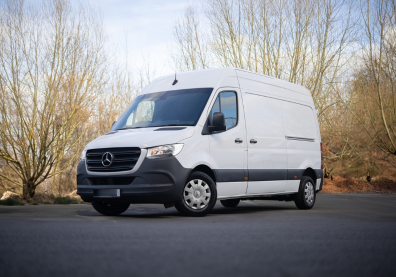We use cookies to make your experience better. To comply with the new e-Privacy directive, we need to ask for your consent to set the cookies. Learn more.


Product Spotlight: The Mercedes-Benz Sprinter celebrates 30 years of success
The Mercedes-Benz Sprinter has long been a popular choice for businesses. As the illustrious model enters its 30th year this year, we’re exploring why and how it has maintained its reputation as the flagship Mercedes-Benz Van.
Back in 1995, Daimler-Benz launched the first-generation Sprinter, to replace the popular T1 Transporter and provide customers with a light commercial vehicle with a reduced aerodynamic drag, an important factor for vehicle efficiency, especially when carrying heavy cargo. This, combined with the powerful diesel engine and increased cabin space, led the Sprinter to be voted “International Van of the Year” in its maiden year.
As the first Mercedes-Benz van with a resonant name, it revolutionised the light commercial vehicle segment in 1995 – and quickly became the namesake for an entire vehicle class. Then as now, it stands for quality and innovation. The Sprinter impresses customers worldwide and has a high repurchase rate, also thanks to its popularity among bodybuilders and conversion specialists, which continue to customise it for a wide range of applications. Seventy-five percent of all Sprinter worldwide are converted.
Second Generation Sprinter
Following the success of the Sprinter in the mid-90s, the second generation was launched at the beginning of 2006. Customers could welcome additional variance: They could choose between three wheelbases, four lengths, three roof heights and a total weight from 3.0 to 5.0 tonnes. In addition, the Electronic Stability Programme ESP® was introduced as standard in the closed versions up to 3.5 tonnes gross weight.
Two years later, it was standard on all body variants up to 3.5 tonnes gross weight. An optional air suspension system to increase comfort and safety was added to the range from 2008. Another milestone followed in 2009 with the introduction of BlueEFFICIENCY: The technology with the new six-speed manual gearbox and automatic start-stop system increased dynamics and noticeably reduced fuel consumption. 2013 saw the introduction of Crosswind Assist, a completely new safety system in a van. From 2016, the Sprinter was available with 5.5 tonnes.
Third Generation Sprinter
Retaining its existing range of variants, the third generation Sprinter introduced front-wheel drive and thus the new traction head variant. The 2018 Sprinter set new standards, particularly in terms of infotainment and connectivity, thanks to the MBUX (Mercedes-Benz User Experience) multimedia system, which was available for the first time in a commercial vehicle. Since then, the Sprinter has been obeying spoken commands and enabled the use of central fleet, vehicle, driver, and location-based services. In terms of safety features, Mercedes-Benz once again raised the vehicle to a new level, for example with DISTRONIC Active Distance Assist.
The next milestone came in 2019: The first production-ready eSprinter panel van was launched, offering the possibility of locally CO₂-emission-free mobility for trade, logistics, and business with its battery-electric drive.
30 years on and more versatile than ever
The triad of efficiency, range and load volume makes the current Mercedes Benz eSprinter a versatile all-rounder. The eSprinter has been available in its current form since 2024; now in two body styles and lengths, as well as with three battery sizes and a range of up to 297 miles (WLTP) [1]. It is based on a new concept consisting of three modules that allow the platform to be easily adapted to further vehicle variants. This also provides completely new possibilities for bodybuilders and conversion specialists to develop industry-specific solutions based on the eSprinter, which is why it is a popular choice among our South West business customers. With a load volume of up to 14 cubic metres and a gross weight of up to 4.25 tonnes, the eSprinter also proves to be just as functional as its counterpart with a combustion engine.
Updates in terms of connectivity and safety have also been available for the eSprinter – as well as for the conventionally powered Sprinter – since last year. Both models benefit from an updated MBUX multimedia system – which is on board as standard now – and new Digital Extras. The safety and assistance systems have also been upgraded with additional and, in some cases, new functions that are already on board for the most part in the standard equipment. For example, the standard Active Brake Assist now includes the cross-traffic function.
With the latest changes, a 22 kW AC charger and a driving assistance package[2] can be ordered as special equipment. The latter includes, for example, additional functions of the Active Distance Assist DISTRONIC (among others Route Based Speed Adaptation and Active Speed Limit Assist ).
Further information can be found here.
Celebrating 30 years of reliability and versatility
For 30 years, the Mercedes-Benz Sprinter has shaped the streetscape worldwide. It is built on three continents – North America, South America, and Europe. This year, Mercedes-Benz has launched a Special Edition to celebrate the model’s anniversary. The special edition showcases everything the Sprinter can do with its extensive equipment and emphasises the premium aspects of the van. Building on the SELECT line (with e.g. comfort seat including lumbar support for the driver, comfort overhead control panel and LED High-Performance headlights including the Adaptive High Beam Assist), the package includes the new driver assistance package and additional comfort features as integrated special equipment with a significant price advantage.
Speak to our teams across the South West in Taunton, Exeter, Plymouth and Truro, to enquire about New and Approved Used Sprinters.
